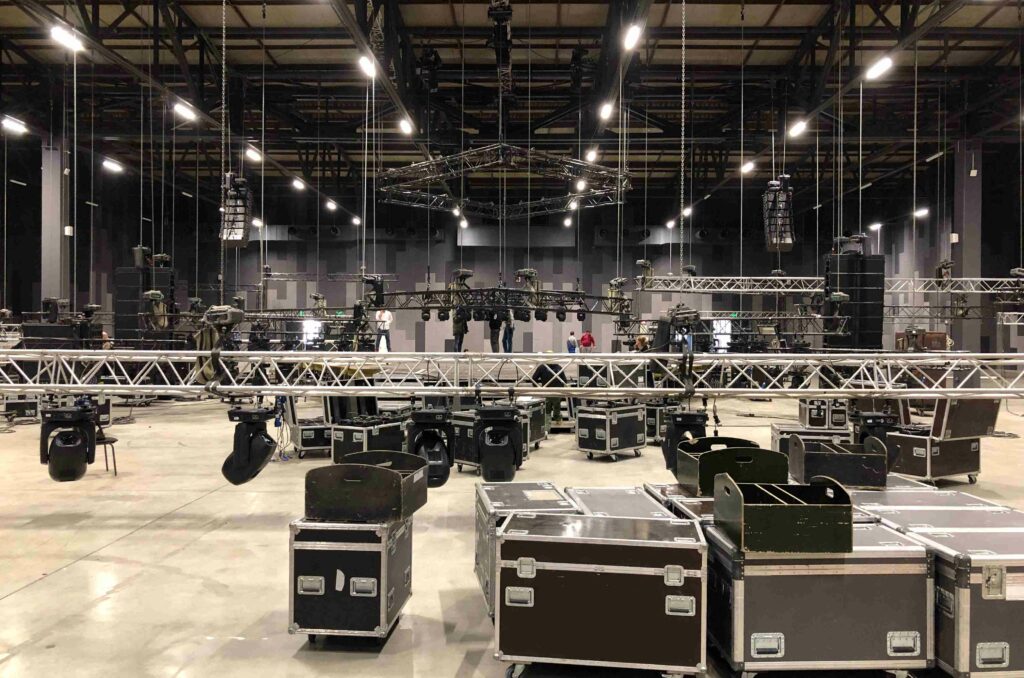Setting up a theatre or stage rigging system can enhance a performance or event and is essential to individual safety.
Here are some essential components to include in your rigging setup.

Essential Stage and Theatre Rigging Equipment
Rigging is designed to hold light fixtures, curtains, scenery and other moving pieces that contribute to the effectiveness of a production.
Fly Systems and Counterweights
A fly system is a structure that supports stage elements that move vertically and horizontally. It includes pulleys, railings, tracks, lift lines, hoists and safety mechanisms. Your fly system can hold curtains, travelers and scrims depending on your design. The fly tower is the section of the fly system above the performance area and houses rigging to lift scrims and backdrops vertically.
Counterweights provide an opposing force to stabilize the movement of curtains, lights and scenery. They’re essential for manual rigging and create a counterbalance on one side of a vector point. Counterweights must be adjusted to change lowering and lifting speed.
Tracks and Railing
Fly rails are attached to pulleys, counterweights and rigging lines to regulate horizontal and vertical movements. Grid rails are in the gridiron, a permanent part of the rigging that functions as a secure workspace for crew members above the stage.
Stage and theatre tracks are in the rails or battens that hang curtains, backdrops and other mobile elements. They’re placed in different locations in the fly system to accommodate specific movements.
Types of tracks include:
- Curtain tracks:These tracks are located at the perimeter of a stage to hide equipment.
- Lighting tracks:Lighting fixtures are attached to adjustable tracks above the stage.
- Scenic tracks:Moveable set pieces are fastened to scenic tracks to change the dynamics of a performance.
Motorized Hoists
Motorized hoists are beneficial if a component of your production requires the same movement multiple times. This type of fly system uses electric motors to assist in moving flown elements. They can be activated by a button or computerized for more complex speed and positioning controls. Motorized hoists need less manual labor but require thorough training to ensure safe operation.
Head Blocks and Arbors
Head blocks control the directional movement of rigging lines. They’re usually located at the top of a fly system and include the mounting hardware, sheaves and frames that reinforce pulleys. Head blocks allow for safe transitions during rehearsals and live performances.
Arbors are mounted on an offstage wall to support the weight of the fly system and battens. Stagehands can control vertical transitions and set changes with an arbor.
Stage and Theatre Rigging Safety Measures
Adhering to rigging protocols will help protect your crew. Safety training can reduce the risk of falls, dropped equipment and toppled structures.
Here are some tips to remember:
- Assess the scope of your project before installing rigging. That includes the venue, crew size, production schedule, design plans and performance description.
- Implement training and certifications for everyone involved in rigging operations.
- Make sure you have the correct lift equipment and your staff knows how to operate it safely.
- Ensure you have the necessary hardware and replace worn or broken components immediately.
- Inspect lines, tracks, connection points and pulleys regularly to spot errors or weak spots.
- Define load limits for your arbor and hoist systems.
- Never lift loads over people or work under a suspended object.
- Use fall arrest systems when working in high places.
Expert Stage and Theatre Rigging Services
Tiffin Scenic Studios offers athletic and performance rigging, custom designs, installations and safety inspections to help you create a quality stage or theatre production. Contact us to learn about our services and get a quote.